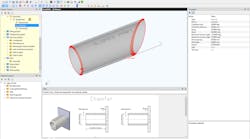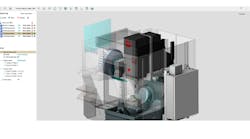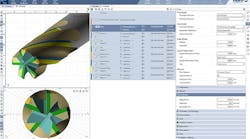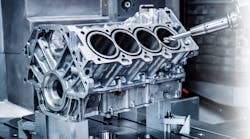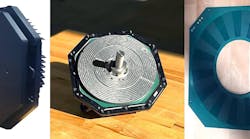Gibbs and Associates has released GibbsCAM VoluMill™ Solids, a new option for the high-speed-machining (HSM) of solid models directly within GibbsCAM. It is available immediately for GibbsCAM 2010 and subsequent releases.
GibbsCAM is a series of programs that supports 2- through 5-axis milling, turning, mill/turning, multi-task simultaneous machining and wire-EDM. GibbsCAM also provides fully integrated manufacturing modeling capabilities, including 2D, 2.5D, 3D wireframe, surface, and solid modeling.
The VoluMill Solids option is described as “an incremental enhancement to the GibbsCAM VoluMill Wireframe option.” Because it is fully integrated within GibbsCAM, it allows users to select solids, surfaces and facet bodies, so they can generate HSM toolpaths quickly and easily with ultra-high performance and efficiency.
Typically, traditional roughing toolpaths are generated as parallel offsets (with sharp corners and transitions), which require stops, starts and variable speeds for optimizing motion to reduce tool wear and excessive tool loading. In contrast, VoluMill develops toolpaths optimized for volumetric material removal, based upon desirable material removal rates, by using continuous tangential motion, specialized contour ramping and adaptive feed rates to achieve the highest feeds and speeds possible.
By leveling tool load, maintaining constant machine-tool motion and using high-speed-repositioning, the software produces more efficient toolpaths, extends tool life and significantly reduces cycle times. Users of GibbsCAM VoluMill Solids option can machine solid models directly, whether they are created in GibbsCAM, SolidWorks, Inventor, CATIA, Pro/ENGINEER Wildfire, Siemens NX, or almost any other CAD system.
“We are quite pleased to be adding yet another tool to help our users increase efficiency and profits,” said Bill Gibbs, founder and president of Gibbs and Associates. “This new option is a testament to our commitment to our customers and their productivity.”
The GibbsCAM VoluMill Wireframe and Solids Package allows users to achieve volumetric material removal on solid, surface and wireframe models, and on any combination of part and stock boundaries. It supports an unlimited number of islands, tapered walls, variable pocket depths and variable island heights.
Other key features that contribute to faster material removal, extended tool life and much shorter cycle times include:
- Programmed rate of material removal to keep tool and work piece temperature consistent, and to dissipate heat with chips;
- Automatic feed rate adjustment and automatic depth of cut to maintain programmed material removal rate, eliminate excessive material conditions, and minimize tool wear, heat build-up and vibration;
- Intelligent side milling and slot milling (with programmer override) to provide the fastest possible cycle time, with feed rates and Z-depth automatically adjusted in slot milling for constant material removal;
- Smoothing radius to maximize tool utilization, minimize cycle time and extend programming flexibility;
- Contour ramping to maximize material removal in tight areas, with safe access, while minimizing cycle time;
- Up to 100% step-over to ensure complete cleanup without leaving any material standing
- Automatically applied special tool motion when tight spaces are detected to ensure fast clearing of small pockets;
- Clean-up milling to allow a smaller tool to clean up material left by a larger tool in a previous operation;
- High-speed-repositioning, with minimal clearance and no tool drag across machined floor, to maximize machine utilization and minimize cycle time.



